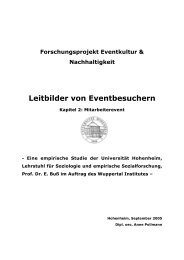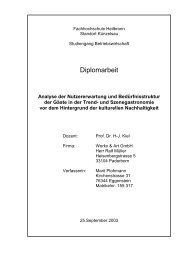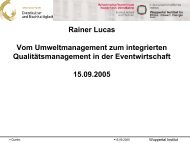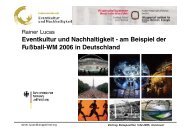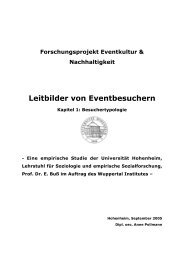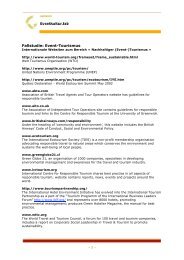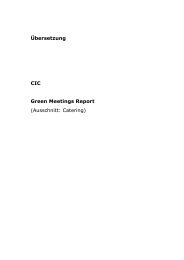environmental management and monitoring for ... - Eventkultur.lab
environmental management and monitoring for ... - Eventkultur.lab
environmental management and monitoring for ... - Eventkultur.lab
You also want an ePaper? Increase the reach of your titles
YUMPU automatically turns print PDFs into web optimized ePapers that Google loves.
Introduction<br />
There is increasing recognition within the sport sector of the economic, health<br />
<strong>and</strong> <strong>environmental</strong> benefits of practising better <strong>environmental</strong> <strong>management</strong>.<br />
This has highlighted the need <strong>for</strong> tools to assist decision-makers. These<br />
valuable tools will help in setting priorities, improving per<strong>for</strong>mance <strong>and</strong><br />
measuring per<strong>for</strong>mance in areas such as: resource consumption, emission of<br />
various pollutants, generation <strong>and</strong> disposal of waste <strong>and</strong> reduction of<br />
<strong>environmental</strong> risks.<br />
This Toolkit is designed as an important contribution to the growing library of<br />
materials avai<strong>lab</strong>le; an introductory resource that supplements some of the<br />
more detailed resources. The focus of this Toolkit is on helping sports<br />
decision makers (principally event organisers, bid groups <strong>and</strong> facilities<br />
operators) to identify their key <strong>environmental</strong> issues, develop strategies to<br />
tackle them, set targets to focus their ef<strong>for</strong>ts, monitor progress <strong>and</strong> use the<br />
avai<strong>lab</strong>le in<strong>for</strong>mation <strong>for</strong> continual improvement.<br />
The Toolkit is divided into several sections, answering some precise questions:<br />
1. What are the main <strong>environmental</strong> health <strong>and</strong> per<strong>for</strong>mance issues?<br />
2. What steps can be taken to address these issues?<br />
3. What are Environmental Per<strong>for</strong>mance Indicators, <strong>and</strong> how can they be<br />
effectively used to improve <strong>management</strong> <strong>and</strong> per<strong>for</strong>mance?<br />
4. What illustrative examples <strong>and</strong> case studies exist?<br />
5. What further resources <strong>and</strong> contacts exist?<br />
Sports events <strong>and</strong> facilities come in many <strong>for</strong>ms, <strong>and</strong> regional conditions can<br />
vary dramatically. This Toolkit has there<strong>for</strong>e been designed to help the user<br />
underst<strong>and</strong> their own priority issues <strong>and</strong> develop their own strategies <strong>and</strong><br />
per<strong>for</strong>mance indicators.<br />
The Toolkit has been developed primarily to serve two categories of users: (i)<br />
major international <strong>and</strong> national games held in Canada; <strong>and</strong> (ii) single sport<br />
world <strong>and</strong> national championships held in Canada. Despite this primary<br />
focus, however, it will be equally useful to smaller event organisers <strong>and</strong><br />
facilities operators.<br />
Managing <strong>and</strong> Monitoring Environmental Per<strong>for</strong>mance of Sports Events <strong>and</strong> Facilities<br />
3



